Stug III: Author Mark Healy produced one of the finest books in the Haynes catalogue with his T-34 manual which appeared a few years back.
His latest offering delves into the nuts and bolts of the Sturmgeschütz III, that most recognisable of assault guns.
This latest volume allows him to cram in a mass of information and some wonderful archive photography. Happily, the quality of the writing makes the history a pleasure to read. This is not a dry, boring tank book.
For me, the StuG will always have me drifting back to my formative years building the Airfix kit version for the sake of playing tank wargames.
There was a good half dozen on the fleet by the end of my involvement in the hobby, by which time I had discovered rock music, cars, girls and photography… but not necessarily in that order.
I came back to tank history some time later and still delight at seeing genuine StuGs, such as Jon Phillips’ magnificent Ausf D variant and the array of repro models built on the FV432 chassis. They all do it for me, even if the latter don’t strictly count. I digress…

The StuG was conceived as mobile artillery but was developed into a tank destroyer, the role for which it is probably best remembered.
The book considers each mark – the Ausf A to E, fitted with the short-barrelled 75mm L/24 gun and the F and G models fitted with the long 75mm L/43 and more powerful L/48.
It is easy to assume that there is a fair degree of commonality between these vehicles, but; this is not so. There is a world of differences in detail between the variants and this highlights the Germans costly failure to standardise.
The first StuGs were built by Daimler-Benz, while the majority were manufactured by Alkett of Berlin. Mr Healy tells us 830 short-barrelled vehicles were built while Alkett produced 702 F and G models before mass production was introduced.
Over seven thousand G models were produced by Alkett and MIAG from January 1943 until the end of the war.
The author takes us on to the Sturmhaubitze III Ausf G, a variant fitted with a 105mm L/28 howitzer. Just over thirteen hundred of this type were produced between 1942 and 1945.

This wouldn’t be as Haynes manual without a whole bunch of technical stuff, and this book doesn’t disappoint. Mr Healy covers every aspect of the StuG before looking at what it was like to operate and the campaigns it fought in.
Needless to say, the lion’s share of combat took place on the Eastern Front. The author knows his subject well, having written the well-received Zitadelle, his account of the Battle of Kursk.
The StuG III also saw service during the Fall of France in 1940, in North Africa, the Balkans, Italy, Finland and in the North-West Europe campaign of 1944-45.
StuGs found their way far and wide with examples serving in Arab armies against the Israelis and used to defend the Bulgarian border in the post-war world.
While so much fuss is made about the Tiger and Panther, it is right to remember that this armoured vehicle is much more of an everyman of the Axis forces than the big cats.

The book includes a traditional walk-around of a restored example, in this case the Ausf G held at the Tank Museum, Bovington.
There is a huge amount of really pleasing archive photography. None of these images are fillers, each has been chosen with care. The effect is to enhance an already superb book even further.
While the 432 based replicas are wonderful in their own right, there is nothing like the real thing. Having Jon Phillips’ Ausf D on the UK circuit has been a real treat in recent years and I much enjoyed seeing it run at the same time as the Tank Museum’s Panzer III at Tankfest last summer.
As ever, a manual like this is a must for fans of armoured vehicles and it will prove especially useful to model makers.
I’ve always thought of the angular StuG as being a most attractive vehicle and on this shallow level the book works really well for me. But there is much more to it than that.
“A Bridge too Far” Tank to Run at TANKFEST!
I’ll be bold and compare this volume to the author’s T34 gem and this underscores the quality of his work as a tank historian. I really cannot recommend this book highly enough.
Reviewed by Mark Barnes for War History Online

STUG III
Sturmgeschütz III
Ausführung A to G (SdKfz 142)
Enthusiasts’ Manual
By Mark Healy
Haynes Publishing
ISBN: 978 1 78521 213 0
